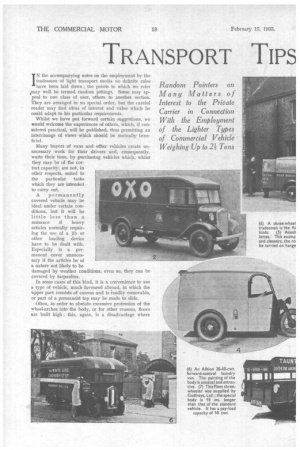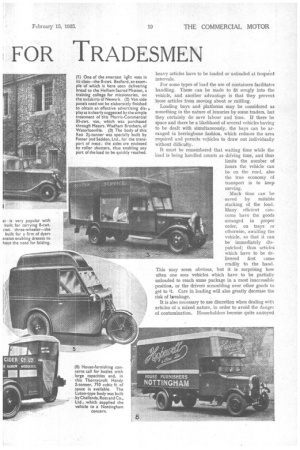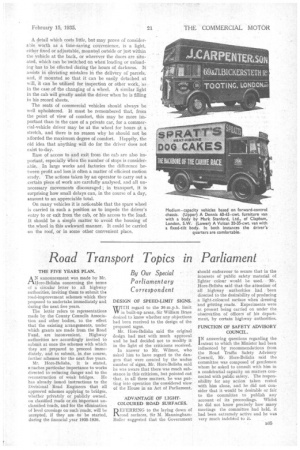TRANSPORT TIPS FOR TRADESMEN
Page 48

Page 49

Page 50

Page 51

If you've noticed an error in this article please click here to report it so we can fix it.
Random Pointers on Many Matters of Interest to the Private Carrier in Connection With the Employment of the Lighter Types of Commercial Vehicle Weighing Up to 21 Tons
IN the accompanying notes on the employment by the tradesmen of light transport media no definite rules have been laid down ; the points to which we refer may well be termed random jottings. Some may appeal to one class of user, others to another section. They are arranged in no special order, but the careful reader may find ideas of interest and value which he could adapt to his particular requirements.
Whilst we have put forward certain suggestions, we would welcome the experiences of others, which, if considered practical, will be published, thus permitting an interchange of views which should be mutually beneficial.
Many buyers of vans and other vehicles create unnecessary work for their drivers and, consequently, waste their time, by purchasing vehicles which, whilst they may be of the correct capacity, are not, in other respects, suited to the particular tasks which they are intended to carry out.
A permanently covered vehicle may be ideal under certain conditions, but it will be little less than a nuisance if heavy articles normally requiring the use of a jib or other loading device have to be dealt with. Especially is a permanent cover unnecessary if the articles be of a nature not likely to be damaged by weather conditions; even so, they can be covered by tarpaulins.
In some cases of this kind, it is a convenience to use a type of vehicle, much favoured abroad, in which the upper part consists of canvas and is readily removable, or part of a permanent top may be made to slide.
Often, in order to obviate excessive protrusion of the wheel-arches into the body, or for other reasons, floors are built high ; this, again, is a disadvantage where
(1) One of the smartest light vans in its class—the 8-cwt. Bedford, an example of which Is here seen delivering bread to the Helium Sacred Mission, a training college for missionaries, on the outskirts of Newark. (2) Van side panels need not be elaborately finished to obtain an effective advertising display as is clearly suggested by the simple treatment of this Morris-Commercial 30-cwt. van, which was purchased through Messrs. Wad ham Brothers, of Waterlooville. (3) The body of this Reo 2i-tormer was specially built by Foster and Seddon, Ltd., for the transport of meat; the sides are enclosed by roller shutters, thus enabling any part of the toad to be quickly reached. heavy articles have to be loaded or unloaded at frequent intervals.
For some types of load the use of containers facilitates handling. These can be made to fit snugly into the• vehicle, and another advantage is that they prevent loose articles from moving about or rattling.
Loading bays and platforms may be considered as •
something in the nature of luxuries by some traders, but they certainly do save labour and time. If there be space and there be a likelihood of several vehidles having to be dealt with simultaneously, the bays can be arranged in herringbone fashion, which reduces the area required and permits vehicles to draw out individually without difficulty.
It must be remembered that waiting time while the load is being handled counts as driving time, and thus limits the number of bolus the vehicle can be on the road, also the true economy of transport is to keep moving.
Much time can be saved by suitable stacking of the load. Many efficient concerns have the goods arranged in proper order, on trays or otherwise, awaiting the vehicle, so that it can be immediately dispatched; thus articles which have to be delivered first come readily to the hand. This may seem obvious, but it is surprising how often one sees vehicles which have to be partially unloaded to reach some package in a most inaccessible position, or the drivers scrambling over other goods to get to It. Care in loading will also greatly decrease the risk of breakage.
It is also necessary to use discretion when dealing with articles of a mixed nature, in order to avoid the danger of contamination. Householders become quite annoyed on finding that their butter smells of paraffm, or that the pâté de foie gias has a flavour of onions.
Cleanliness is, of course, essential. It is advisable that the van should be swept out after each load, unless the goods carried are of a nature which disposes of this need.
The economical running of a vehicle depends to a great extent upon the proper distribution of its load. There should be no concentration, particularly immediately above or behind the rear axle. It is not good practice to carry articles bulging from the rear doors or supported on a tailboard which has been partially let down.
Money can be saved by paying proper and frequent attention to the tyres. If these be too hard they will cause rough riding and, possibly, damage to the goods carried, whilst if too soft they will wear rapidly.
Often a vehicle is delayed unduly at the loading point, not through the time taken in actually arranging the
load, but because the packages, etc., are not immediately available. In this connection, it sometimes proves an economy to institute some form of conveyer system within the premises of the vehicle owner.
In some of the important London stores there are situated in the basements rotating tables upon which the packages of merchandise are deposited from chutes, reaching to them from various parts of the building. Men standing around these tables sort out the packages as they come within their reach, and deposit them either direct into trollies or into bins from which they are removed later, according to their destinations. They are then taken by other conveyers or by the aforesaid trollies to the dispatch de
partment. Such internal arrangements may be considered as hardly within the province of road transport, but, actually, they exercise an important bearing upon it, particularly so when vehicles have to wait in the street and are there liable to attract the attention of the authorities if the stay be unduly prolonged.
In some businesses the good appearance of a vehicle counts for even more than its load capacity ; consequently, the latter is sometimes sacrificed in some degree to permit the mounting of an elaborate form of body. Such cases must, of course, be decided on their merits, but; undoubtedly, the attractive vehicle, whether of a normal or unusual type, has a publicity value of considerable importance.
In the selection of drivers and assistants too for loading, etc., if these be employed, it pays to exercise great care. Apart from the inconvenience, delay and expense resulting from accidents, even if they amount only to the damaging of a wing, there is the point that everyone now should do his utmost to assist in improving the safety of the road ; whilst a concern, the drivers of which earn a bad name, may have reflected upon it some of the opprobrium thus provoked.
A detail which costs little, but may prove of considerable worth as a time-saving convenience, is a light, either fixed or adjustable, mounted outside or just within the vehicle at the back, or wherever the doors are situated, which can be-switched on when loading or unloading has to be effected during the hours of darkness. It assists in obviating mistakes iri the delivery otparcels, and, if mounted so that it can be easily detached at mill, it can be utilized for inspection or other wOrk, as in the case of the changing of a wheel. A similar light in the cab Will greatly assist the driver when he is filling in his record sheets.
The seats of commercial vehicles should always be well upholstered. It must be remembered that, from the point of view of comfort, this may be more important than in the case of a private car, for a commercial-vehicle driver may be at the wheel for hours at a stretch, and there is no reason why he should not he afforded the maximum degree of comfort. Happily, the old idea that anything will do for the driver does not exist to-day.
Ease of access to and exit from the cab are also important, especially When the number of stops is considerable. In large works and factories the difference between profit and loss is often a matter of efficient motion study. The actions taken by an operator to carry out a certain piece of work are carefully analysed, and all unnecessary movements discouraged ; in transport, it is surprising how small delays can, in the course of a day, amount to an appreciable total.
On many vehicles it is noticeable that the spare wheel is carried in such a position as to impede the driver's entry to or exit from the cab, or his access to the load. It should be a simple matter to avoid the housing of the wheel in this awkward manner. It could he carried on the roof, or in some other convenient place.




























































































